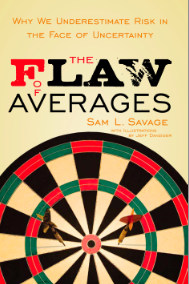We have been tutoring CFA, CPA and MBA students in simulation or more specifically, in “Monte Carlo Simulation” since 2007. We tutored students in Monte Carlo simulation using Oracle’s Crystal Ball and Palaside’s @Risk simulation software. We recently stumbled upon Dr. Sam Savage’s work in this area when a student requested tutoring in Monte Carlo simulation using XLSim. We had not used the XLSim add-in before and have tutored hundreds of students in Monte Carlo simulation using Oracle’s Crystal Ball and Palaside’s @Risk expensive simulation software. As we started doing more research into XLsim, we discovered that although the student version is supported on Mac and PC through Excel 2013, Dr. Savage has now developed a new approach to simulation, called SIPmath, which first, runs in native Excel without macros or add-ins, and second, will perform tens of thousands of trials before your finger leaves the <Enter> key. That is, unlike Crystal Ball and @RISK, this is fully interactive simulation. The open SIPmath™ standard developed by Dr. Savage’s non-profit, ProbabilityManagement.org, refers to computations done with SIPs or Stochastic Information Packets which is an uncertainty modeled as an array of possible outcomes. What we found when we did more research into SIPmath delighted us on many fronts.
- First, the SIPmath tools are free to all who register at ProbabilityManagement.org. The video at the top of the tools page provides a good overview of capabilities.
- Second, SIPmath allows users of Oracle’s Crystal Ball and Palaside’s @Risk to create SIP libraries to be used in interactive simulations by native Excel. This allows statistical experts using these high end tools, to distribute interactive models to a wide audience.
- Third, although the tools describe above are all in the Excel environment, the SIPmath concept is platform agnostic, and supports XLSX, CSV and XML file formats.
The basic concept is this. Uncertainties are represented as thousands of possible outcomes. For example, the SIP representing the roll of a die consists of thousands of simulated rolls stored in Excel or a database. The associated metadata would include the number of rolls and the name of the person who rolled the die. “SIPs are an ideal means for modeling and conveying uncertainty in a standardized fashion,” said Eric Wainwright, Co-Founder and Chief Technology Officer of Oracle’s Crystal Ball simulation package. “The standard will play an increasing role in the way organizations manage uncertainty through their informational and predictive systems.” Three wonderful aspects of SIPs are that:
- SIPs are actionable in that they may be used as inputs to interactive simulations in Excel.
- SIPs are additive, in that the results of multiple simulations run on different platforms may be aggregated.
- SIPs are auditable, because the trials are simply data with associated meta data and provenance.
Native Excel can instantly run thousands of SIPs through a model before the user’s finger leaves the Enter key using the Data Table function. The SIPmath Modeler Tools facilitate the creation of such models but are not required to run them, making them sort of a goose that lays golden eggs. ProbabilityManagement.org offers another tool, called SIPmaker, which uses the XLSim simulation engine to automatically generate SIPs for those without Crystal Ball. SIPmaker will also create SIPs from any existing XLSim model.
For users of Crystal Ball and @RISK, the non-profit provides macros that create the libraries for use in SIPmath models. GraduateTutor.com’s operation research and decision modeling tutors can assist you with tutoring for Monte Carlo simulation using XLSim and SIPmath.
Dr. Sam Savage
SIPmath development was led by Dr. Sam Savage. He is on a mission to cure the ‘flaw of averages’. And SIPmath is a byproduct of his mission.
“Plans based on average assumptions are wrong on average.”
SIPmath is a result of many breakthroughs – William Sharpe, the economics Nobel laureate started doing simulation with Data tables in Lotus 1,2,3. Dr. Savage experimented with simulations using Microsoft Excel since the 1990s. In the 2000 edition of his text book, Dr. Savage had an exercise to build a Monte Carlo simulation using Microsoft Excel’s data tables. However, at that point in time, Microsoft Excel would crash. Over time, computing power increased and Microsoft Excel got serious capacity and it was in 2012 that Dr. Savage realized that he could effectively build a Monte Carlo simulation tool based on Microsoft Excel. Dr. Savage said
“None of my successes have been planned. None of my plans have been successes.”

Dr. Savage is a consulting professor at Stanford’s Management Science and Engineering department. He has in the past taught Management Science at the University of Chicago’s Graduate School of Business and been a visiting professor at Northwestern University’s Kellogg School and the Naval Postgraduate School in Monterrey. Dr. Savage did his Ph.D. in the field of computer science, from Yale University in 1973.
In addition to his book “The Flaw of Averages”, Dr. Savage has also authored Decision Making with Insight and Insight.xla which Harry Markowitz, a Nobel Laureate in Economics, calls “a must read”. He is also a published author in the Harvard Business Review, Journal of Portfolio Management, ORMS Today, etc.
Dr. Sam Savage is founder and president of AnalyCorp Inc., a firm that develops executive education programs and software for improving business analysis. He is also the Executive Director of Probability Management, a 501(c)(3) non profit that promotes the understanding of uncertainty and counters the flawed use of averages.